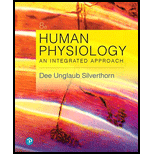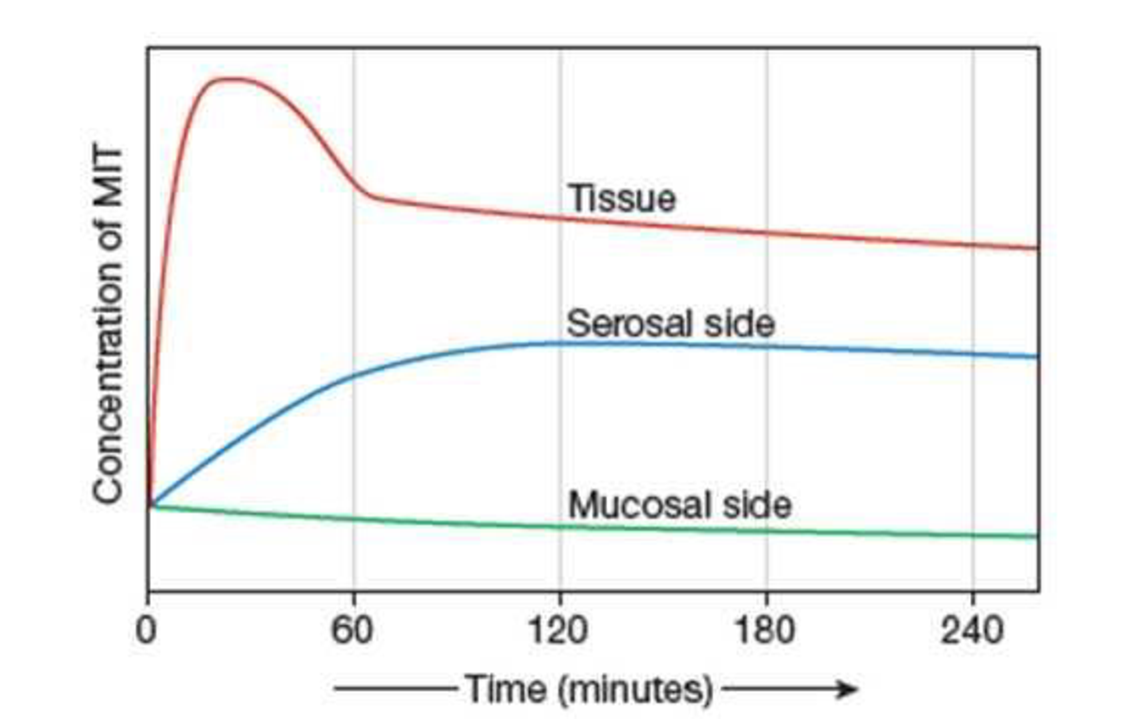
Human Physiology: An Integrated Approach (8th Edition)
8th Edition
ISBN: 9780134605197
Author: Dee Unglaub Silverthorn
Publisher: PEARSON
expand_more
expand_more
format_list_bulleted
Textbook Question
Chapter 21, Problem 25RQ
Intestinal transport of the amino acid analog MIT (monoiodotyrosine) can be studied using the “everted sac” preparation. A length of intestine is turned inside out, filled with a solution containing MIT, tied at both ends, and then placed in a bath containing nutrients, salts, and an equal concentration of MIT. Changes in the concentration of MIT are monitored in the bath (mucosal or apical side of the inverted intestine), in the intestinal cells (tissue), and within the sac (serosal or basolateral side of the intestine) over a 240-minute period. The results are displayed in the graph shown here. (Data from Nathans et al., Biochimica et Biophysica Acta 41: 271–282, 1960.)
- a. Based on the data shown, is the transepithelial transport of MIT a passive process or an active process?
- b. Which way does MIT move: (1) apical to tissue to basolateral, or (2) basolateral to tissue to apical? Is this movement absorption or secretion?
- c. Is transport across the apical membrane active or passive? Explain your reasoning.
- d. Is transport across the basolateral membrane active or passive? Explain your reasoning.

Expert Solution & Answer
Want to see the full answer?
Check out a sample textbook solution
Students have asked these similar questions
Diagram of check cell under low power and high power
a couple in which the father has the a blood type and the mother has the o blood type produce an offspring with the o blood type, how does this happen? how could two functionally O parents produce an offspring that has the a blood type?
What is the opening indicated by the pointer? (leaf x.s.)
stomate
guard cell
lenticel
intercellular space
none of these
Chapter 21 Solutions
Human Physiology: An Integrated Approach (8th Edition)
Ch. 21.1 - Prob. 1CCCh. 21.1 - Prob. 2CCCh. 21.1 - Prob. 3CCCh. 21.2 - Define digestion. What is the difference between...Ch. 21.2 - Prob. 5CCCh. 21.2 - Draw a cell showing (1) an enzyme in a cytoplasmic...Ch. 21.2 - Prob. 7CCCh. 21.2 - Prob. 8CCCh. 21.2 - Prob. 9CCCh. 21.3 - Prob. 10CC
Ch. 21.4 - Prob. 11CCCh. 21.6 - Do bile salts digest triglycerides into...Ch. 21.6 - Prob. 13CCCh. 21.6 - Prob. 14CCCh. 21.6 - What activates pepsinogen, trypsinogen, and...Ch. 21.6 - Prob. 16CCCh. 21 - Match each of the following descriptions with the...Ch. 21 - Prob. 2RQCh. 21 - Prob. 3RQCh. 21 - Prob. 4RQCh. 21 - Prob. 5RQCh. 21 - Prob. 6RQCh. 21 - What purposes does motility serve in the...Ch. 21 - Prob. 8RQCh. 21 - Match each of the following cells with the...Ch. 21 - Prob. 10RQCh. 21 - Prob. 11RQCh. 21 - Prob. 12RQCh. 21 - Prob. 13RQCh. 21 - What role do paracrines play in digestion? Give...Ch. 21 - Prob. 15RQCh. 21 - Prob. 16RQCh. 21 - Prob. 17RQCh. 21 - Prob. 18RQCh. 21 - Prob. 19RQCh. 21 - Prob. 20RQCh. 21 - Prob. 21RQCh. 21 - Prob. 22RQCh. 21 - Mary Littlefeather arrives in her physicians...Ch. 21 - Using what you have learned about epithelial...Ch. 21 - Intestinal transport of the amino acid analog MIT...
Knowledge Booster
Learn more about
Need a deep-dive on the concept behind this application? Look no further. Learn more about this topic, biology and related others by exploring similar questions and additional content below.Similar questions
- Identify the indicated tissue? (stem x.s.) parenchyma collenchyma sclerenchyma ○ xylem ○ phloem none of thesearrow_forwardWhere did this structure originate from? (Salix branch root) epidermis cortex endodermis pericycle vascular cylinderarrow_forwardIdentify the indicated tissue. (Tilia stem x.s.) parenchyma collenchyma sclerenchyma xylem phloem none of thesearrow_forward
- Identify the indicated structure. (Cucurbita stem l.s.) pit lenticel stomate tendril none of thesearrow_forwardIdentify the specific cell? (Zebrina leaf peel) vessel element sieve element companion cell tracheid guard cell subsidiary cell none of thesearrow_forwardWhat type of cells flank the opening on either side? (leaf x.s.) vessel elements sieve elements companion cells tracheids guard cells none of thesearrow_forward
- What specific cell is indicated. (Cucurbita stem I.s.) vessel element sieve element O companion cell tracheid guard cell none of thesearrow_forwardWhat specific cell is indicated? (Aristolochia stem x.s.) vessel element sieve element ○ companion cell O O O O O tracheid O guard cell none of thesearrow_forwardIdentify the tissue. parenchyma collenchyma sclerenchyma ○ xylem O phloem O none of thesearrow_forward
- Please answer q3arrow_forwardRespond to the following in a minimum of 175 words: How might CRISPR-Cas 9 be used in research or, eventually, therapeutically in patients? What are some potential ethical issues associated with using this technology? Do the advantages of using this technology outweigh the disadvantages (or vice versa)? Explain your position.arrow_forwardYou are studying the effect of directional selection on body height in three populations (graphs a, b, and c below). (a) What is the selection differential? Show your calculation. (2 pts) (b) Which population has the highest narrow sense heritability for height? Explain your answer. (2 pts) (c) If you examined the offspring in the next generation in each population, which population would have the highest mean height? Why? (2 pts) (a) Midoffspring height (average height of offspring) Short Short Short Short (c) Short (b) Short Tall Short Tall Short Short Tall Midparent height (average height of Mean of population = 65 inches Mean of breading parents = 70 inches Mean of population = 65 inches Mean of breading parents = 70 inches Mean of population = 65 inches Mean of breading parents = 70 inchesarrow_forward
arrow_back_ios
SEE MORE QUESTIONS
arrow_forward_ios
Recommended textbooks for you
 Human Physiology: From Cells to Systems (MindTap ...BiologyISBN:9781285866932Author:Lauralee SherwoodPublisher:Cengage Learning
Human Physiology: From Cells to Systems (MindTap ...BiologyISBN:9781285866932Author:Lauralee SherwoodPublisher:Cengage Learning Biology 2eBiologyISBN:9781947172517Author:Matthew Douglas, Jung Choi, Mary Ann ClarkPublisher:OpenStax
Biology 2eBiologyISBN:9781947172517Author:Matthew Douglas, Jung Choi, Mary Ann ClarkPublisher:OpenStax

Human Physiology: From Cells to Systems (MindTap ...
Biology
ISBN:9781285866932
Author:Lauralee Sherwood
Publisher:Cengage Learning





Biology 2e
Biology
ISBN:9781947172517
Author:Matthew Douglas, Jung Choi, Mary Ann Clark
Publisher:OpenStax
Human digestive system - How it works! (Animation); Author: Thomas Schwenke;https://www.youtube.com/watch?v=X3TAROotFfM;License: Standard Youtube License